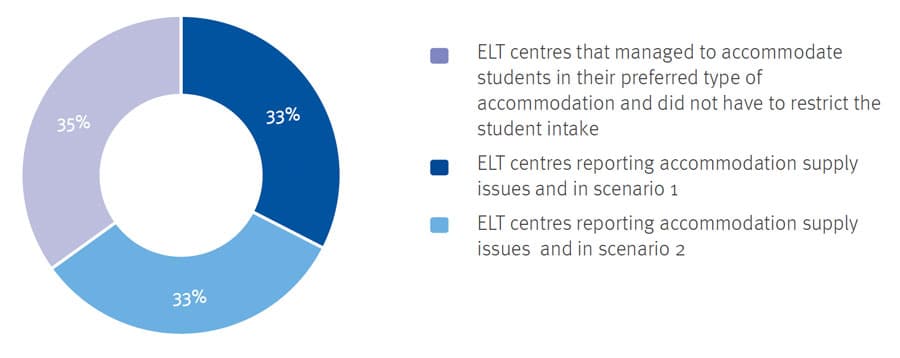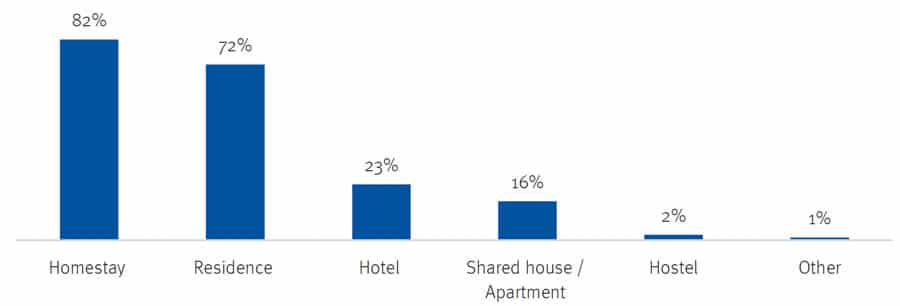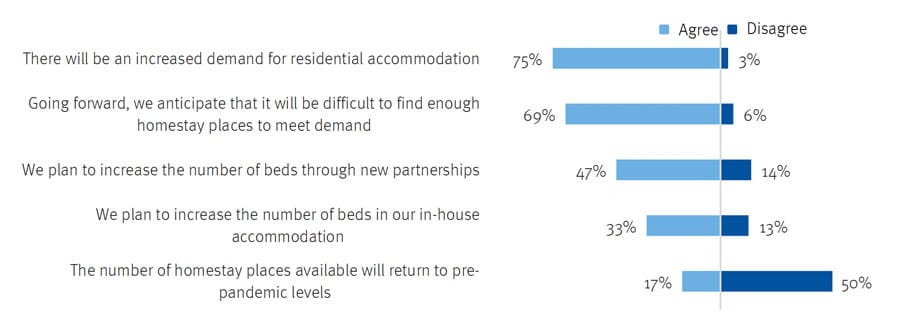UK ELT providers report restricting enrolment because of bed shortages
- A survey of UK ELT providers makes a clear connection between a shortage of suitable housing and student recruitment
- Based on responses from 91 English UK members, the sector needed nearly another 7,000 beds than were available last year
- Because of that housing shortage, nearly two-thirds of responding centres indicated that they found it necessary to restrict their student intakes in 2023
A new report from English UK draws on survey responses from 91 member centres to conclude that many ELT schools in the country found it necessary to limit enrolment in 2023 because of a shortage of suitable student housing.
Responding ELT providers cumulatively reported a shortage of more than 6,600 beds last year, a shortage which led many to constrain student numbers.
The following chart provides a high-level breakdown of the scale of housing challenge for reporting ELT centres. It illustrates that just over a third (35%) did not have to restrict their student intakes due to housing. Nearly two-thirds, however, did report significant housing impacts. The "scenario 1" referred to in the chart describes "ELT centres that managed to place all their students in their preferred type of accommodation type because they restricted the 2023 student intake". Meanwhile, "scenario 2" refers to centres that "restricted the size of student intake in 2023 and still did not manage to place all their students in their preferred type of accommodation."
In other words, two-thirds of the responding ELT schools found it necessary to limit their student intakes in 2023 due to housing constraints.

The report concludes that, "Totalling the figures from scenarios 1 and 2, cumulatively, 66% of the respondents reported accommodation shortages. These respondents could have used over 6,600 additional beds: 3,815 in residences and 3,358 in homestay places…This means that, potentially, 6,600 more students could have been enrolled by these UK ELT centres in 2023."
The additional chart below outlines the main types of housing offered by providers within the sector, with most relying on homestay (82%) and residence (72%) options.

Nearly half (42%) of responding centres indicated in the survey that they were working to increase the number of beds available to their students for summer 2024, but, as we see in the next chart below, there is broad consensus around some of the important housing issues facing the sector when it comes to student housing.

The report concludes that national advocacy campaigns to recruit additional homestay families, and expanded partnerships between schools and local housing providers or institutions, will be key steps to ease the housing challenge for the sector going forward.
"A lack of suitable student accommodation impacts every stakeholder in the international education sector: it can jeopardise the student experience, hinder recruitment efforts, and ultimately damage the reputation of a study destination," adds the report, which can be commended for the concrete evidence it provides as to how housing constraints directly impact recruitment and student intake.
For additional background, please see:
- ICEF Accommodation: The world’s first-ever agent networking event where providers of student accommodation and related services meet with international student recruitment professionals.
- "How many students for how many beds? Managing supply and demand in UK student housing"
- "Student housing crunch worsens across Europe, Australia, Canada"
- "Continuing housing crunch opens the door to innovation and new strategies"
- "What if there is no room? The link between student housing and enrolment capacity"















